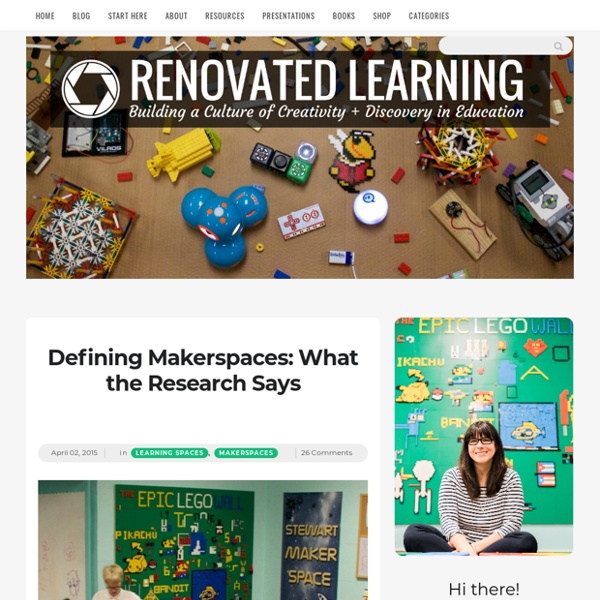Setting Up Your Own MakerSpace
Since you already know that you want to set up a MakerSpace you know that it is an area that provides hands-on, creative ways for students to design, experiment, and invent as they engage in science, engineering, and tinkering.” (definition from edutopia) Before I started making specific plans for a MakerSpace in my library, I started reading everything that I could get my hands on that would inform me about such a space. I read online, searched out other libraries, schools, classrooms, and communities that had MakerSpaces, hit the library and Amazon looking for books about MakerSpaces, visited several MakerSpaces in the area, read blogs about MakerSpaces, and followed makers on Twitter. Even though I have a MakerSpace up and successfully running, I am still seeking out any information I can that will improve my space for my students.
Designing Innovative Library Spaces
A Librarian's Guide to Makerspaces: 16 Resources
"There were more than 135 million adult makers, more than half of the total adult population in America, in 2015." What is a makerspace? You’ve no doubt been hearing that word more than a few times over the past several years. There were more than 135 million adult makers, more than half of the total adult population in America, in 2015. Articles & Blog Posts on Makerspaces 1.) 2.) 3.) 4.) 5.) 6.) 7.) 8.) 9.) 10. ) It all started with a training offered by the Washington State Library… Part of the “Between the Lines” series of the Washington State Library Blog, this post describes one library manager’s first encounter with STEM-based makerspace programming. 12.) Maker Faire Touted as the “greatest show and tell on earth,” Maker Faire has emerged as the official international celebration of not only creativity, resourcefulness, and innovation but also a mass gathering of the maker movement at large. Makerspaces Directories 1.) 2.) 3.) 4.) Revitalizing Community Spaces
Heart pillow (no-sew)
Have a look at this easy way to make such a pillow from felt fabric or polar fleece (the cloth must threadless). You need felt fabric (polar fleece) in two different colors, scissors, and wadding (cotton) to stuff the pillow with, when it is ready. Put the fabrics one over the other. Cut a big heart. Start to tie every two stripes, which one over another. Tie all the stripes in this way. Do not forget to stuff the heart with wadding or cotton before you close the heart. At the end, you can reduce the length of the stripes to make your heart bushy. see also:
The ideas behind a school makerspace and its benefits for students – Rock Island Techie
When I first heard about makerspaces, I wondered what was so unique about such spaces and what differentiated them from a classroom with materials for projects, the room I use as an office and keep all my art, tech, and office supplies, or even the garage or shed that my husband keeps all his tools and gear for various things. As I’ve learned more about makerspaces, I’ve realized that all these places (and many more) CAN be makerspaces and probably are often used that way from time to time. In a school makerspace, the actual space and tools (or supplies and resources) are just part of the equation; so what is the pedagogy behind a maker space in schools and how does that benefit students? “Diversity and cross-pollination of activities are critical to the design, making and exploration process, and they are what set makerspaces and STEAM labs apart from single-use spaces” (Cooper, 2013, para 2). What does this mean for the teacher utilizing a makerspace with their students? References:
21st-Century Libraries: The Learning Commons
Libraries have existed since approximately 2600 BCE as an archive of recorded knowledge. From tablets and scrolls to bound books, they have cataloged resources and served as a locus of knowledge. Today, with the digitization of content and the ubiquity of the internet, information is no longer confined to printed materials accessible only in a single, physical location. Consider this: Project Gutenberg and its affiliates make over 100,000 public domain works available digitally, and Google has scanned over 30 million books through its library project. Start of newsletter promotion. Get our essential newsletter featuring must-read articles on the education topics that matter to you—it’s personalized and delivered every Wednesday. Sign up for free End of newsletter promotion. Libraries are reinventing themselves as content becomes more accessible online and their role becomes less about housing tomes and more about connecting learners and constructing knowledge. Transparent Learning Hubs
Makey Makey | Buy Direct (Official Site)
5 Makerspace Books You Need to Read | Knowledge Quest
There’s so many amazing books coming out now related to starting a school makerspace, and many of them are fantastic. But for this post, I want to take a look back and focus on the five books that had the biggest impact on me as I was planning and creating my makerspace at Stewart Middle Magnet School. This was back in late 2013/early 2014, when there wasn’t a ton of stuff out there that specifically focused on school makerspaces. Even without a direct focus on library makerspaces, these books still had a profound impact in shaping my thinking about creating an innovative, playful learning environment. Invent To Learn: Making, Tinkering, and Engineering in the Classroom Maybe this one is obvious, but it still has to be here. The Art of Tinkering This book comes from The Exploratorium, an amazing hands-on science museum in San Francisco. The Art of Tinkering looks at over 150 different artists and makers and how they weave science and technology into their work. The Third Teacher Like this:



